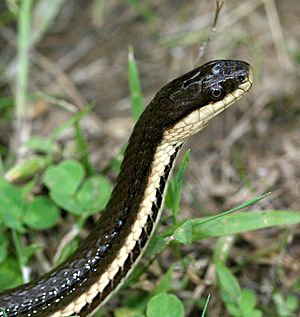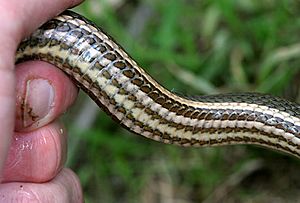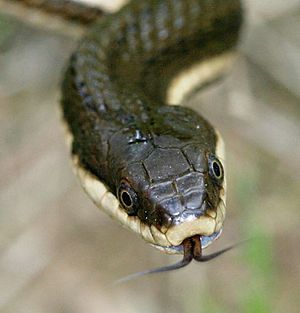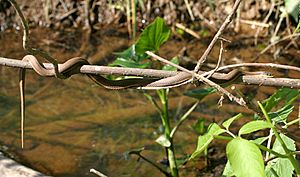Queen snake facts for kids
Quick facts for kids Queen snake |
|
|---|---|
 |
|
| Conservation status | |
| Scientific classification | |
| Genus: |
Regina
|
| Species: |
septemvittata
|
| Synonyms | |
The queen snake (Regina septemvittata) is a type of non-venomous snake. It lives partly in water and partly on land. This snake belongs to the Colubridae family. You can find it only in North America.
Contents
What is a Queen Snake?
The queen snake has many other names. Some people call it the banded water snake. Others know it as the seven-striped water snake. It is also called the willow snake or yellow-bellied snake.
Where Do Queen Snakes Live?
Queen snakes live in the eastern part of North America. They are found east of the Mississippi River. Their range goes from western New York to Wisconsin. They also live south to Alabama and northern Florida. You can find them in southwestern Ontario too.
This snake used to live in New Jersey. But now, it is thought to be gone from that state.
What Does a Queen Snake Look Like?
The queen snake looks a bit like a garter snake. People often confuse them. Queen snakes are olive, gray, or dark brown. They have peach or yellow stripes along their sides. These stripes are near the first row of scales.
They also have four dark stripes on their belly. No other similar snake has stripes on its belly. This helps you tell them apart. Young snakes have three more stripes. One stripe runs down their back. Two more stripes run along their sides.
Seven Stripes on Young Snakes
When young, these snakes have seven stripes in total. Three are on their back and four are on their belly. This is why they are called Regina septemvittata. Regina means queen, and septemvittata means seven-striped. As they get older, these extra stripes fade. The snake's belly is usually cream or yellow.
Head and Size
A queen snake's head is narrow. It has nine large, flat scales on top. Its chin has thick scales. These scales protect the snake when it hunts under rocks. Its eyes have round pupils, like most other colubrid snakes.
Queen snakes are not very big. They rarely grow longer than 24 inches (61 cm) (61 cm). Females are usually a bit larger than males.
Reproduction and Life Cycle
Female queen snakes can have babies when they are three years old. Males are ready at two years old. They usually breed in spring and autumn. If they mate in autumn, the female can wait until spring to give birth. She saves her energy during the cold months.
Live Births
Queen snakes give birth to live young. The mother carries the eggs inside her body. This is called ovoviviparous. It is different from snakes that lay eggs. A mother can have 5 to 20 babies at a time. Each birth takes about 1.5 to 2.5 minutes. There can be 4 minutes to 1 hour between births.
Newborn snakes are about 6 in (15 cm) (15 cm) long. They weigh about 0.1 ounces (2.8 g) (3 grams). They grow very fast. They might shed their skin twice in their first week. Baby snakes can swim and move right away. They must take care of themselves after birth.
What Do Queen Snakes Eat?
Queen snakes need very specific places to live. They are only found near clean, flowing streams. These streams must have rocky bottoms. The water needs to be at least 50 °F (10 °C) (10°C) when the snakes are active. This is because of what they eat.
Crayfish Diet
Queen snakes eat mostly fresh water crayfish. They especially like crayfish that have just molted. These crayfish are soft and cannot use their pincers to defend themselves. One study showed that crayfish make up over 90% of their diet.
They might also eat frogs, tadpoles, newts, minnows, snails, and fairy shrimp. Queen snakes do not use their eyes or heat to find food. They use their sense of smell. They flick their tongue to pick up scents. This helps them find prey, even underwater.
Queen Snake Habits
Queen snakes spend the winter months in a sleepy state called brumation. Groups of them can be found in "hibernacula." These are places where they hibernate near water. They might use old bridges, cracked walls, or rock crevices. During this time, they are slow. Crayfish, their usual food, might even become a danger to young snakes.
Daily Life and Defense
Queen snakes are active during the day. This is called being diurnal. But they can also hunt at night. You can often find them by turning over rocks near streams. They also come out of the water to warm up in the sun. They often sit on branches or roots near the water's edge.
Queen snakes are very aware of danger. They will drop into the water if disturbed. They are usually calm snakes and do not often bite. They can be handled easily. However, if you pick one up, it might release a smelly liquid. This is a defense, like what garter snakes do.
Threats to Queen Snakes
Animals that eat queen snakes include raccoons, otters, mink, hawks, and herons. Large frogs and fish also eat young snakes. The biggest danger to queen snakes is losing their homes. This happens when waterways are drained, disturbed, or polluted.
Crayfish, their main food, are sensitive to pollution. If the water gets polluted, crayfish die. This causes the queen snake population to shrink. In many places, queen snakes have disappeared or are in danger.





